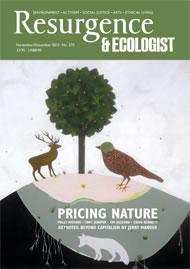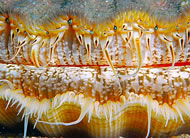The sun is glittering on the seawater on a cool June afternoon. I am wading with some trepidation into the icy-cold water, with my ripped wetsuit and antiquated snorkel. I set my jaw and take the plunge. Once the initial shock has passed, I can focus on the extraordinary world in which I am now immersed. This is a strange and alien place. I have the feeling of being privileged to witness something that most people never will – like an impossibly dazzling skyscape following a thunderstorm at sunset.
There are long, many-fingered fronds reaching up from the deep and occasionally stroking my face and fingers as I pass – a slightly unnerving feeling. Sometimes these rise alone from an invisible sea floor like slippery redwoods; elsewhere they form thick stands. Occasionally a mass of rock looms up and pink sea fans and myriad multicoloured life forms crowd over the submerged crags and crevices. Further out into the bay an old shipwreck suddenly takes shape in the murky waters. I don’t know exactly why, but this makes me feel uneasy. It is almost totally encrusted with sea life, and only a couple of sharp, well-rusted metallic fragments protrude.
I am reasonably confident naming most of the common plants or birds I might see on land. But here I have no idea whether half the life forms I’m seeing are animals or plants. To me this is life at its most wild – not so much unaffected by humans, but scantily mapped, poorly understood and largely unseen. And the whole landscape, stuffed with life, visibly dances to its own rhythm – a slightly melancholic swaying with the gentle currents and surf of the harbour. This feels like going back into primeval time, where life began and before it evolved into the much more familiar forms we see on land today. A menagerie of strange shapes and bizarre evolutionary experiments, into which we intrude.
This is just one of the many extraordinary marine habitats in the seas surrounding Britain, and by no means the best – I didn’t even get to swim out of the harbour. We have eelgrass beds full of sea horses, a species in which it is the males that give birth. We have reefs off the south coast covered with sea fans. We have spectacular ridges and canyons rolling out in strange submarine landscapes, and huge sand-wave formations out in the English Channel. Our massive tides mean that we have communities of plants and animals that have adapted to live in a state of almost perpetual cyclone. Our seas are home to dolphins, whales, cuttlefish, rays – in fact much of the sea life that we would expect to see in the best wildlife documentary.
It is an often cited, yet nevertheless tragic reality that most of the world’s major fisheries are just shadows of their former selves, and those round British coasts are no exception. What is much less well known is the plight of marine habitats, which are being ravaged by climate change, pollution and large-scale, commercial trawler fishing. There are of course plenty of fishing practices that have a relatively benign impact, but some, like scallop dredging, involve scraping the seabed with huge metal combs. These don’t just remove the scallops – they smash everything in their path, and can destroy entire reef habitats.
In the UK about half of our biological diversity lies in the seas. We are lucky enough to have some of the best habitats in the South West, such as around the island of Lundy, where the recovery of many species in the absence of intensive fishing can be seen clearly. And yet less than 2% of UK waters are afforded any protection. This compares with approximately 10% of terrestrial habitats, a figure that most scientists agree is much too low.
So why have we done so little to protect the seas? Safeguarding marine wildlife has always been hugely controversial. The political debate has generally revolved around economic issues, the perceived threats to coastal communities or long-held fishing traditions. But I think the real reasons lie deeper. We have never been good at valuing what we cannot directly experience. For most of us, what lies beneath the waves is as distant from our day-to-day cares as what lies out in deep space. It is much easier to picture and sympathise with the hard-pressed fishing community than it is to feel empathy with unfamiliar creatures of the gloomy depths.
The sea may no longer be the uncharted and terrifying wilderness it once was, but it is perhaps the last place where we hunt and gather on such a large scale. With all our modern technology and huge ships we have not tamed the seas and – unlike the land – we can hardly claim to manage them in any real sense. Making a living from the sea is human versus Nature in its rawest sense, and what we take from it we have not bought, farmed or grown: we have won it.
Seen in this context, it is perhaps understandable that some groups resent any talk of restrictions on how we use the sea. But it is of course a fallacy to believe that we can keep taking more and more on an ever-greater scale and that the oceans will simply replenish their own stocks. Many traditional hunter-gatherer societies long recognised this reality and so respected sacred areas where hunting was not permitted and forests were not to be cleared.
One conservation campaign that is well advanced is the one that could now see 127 Marine Conservation Zones (MCZs) around the English coasts (a similar process is under way in Scotland, Wales and Northern Ireland). Some of these protected zones are adjacent to the coast, such as the Skerries Bank in South Devon, and others, such as the Canyons, are hundreds of miles offshore on the very edge of the continental shelf. They are hugely varied, taking in sandbanks, reefs, kelp forests, estuaries and drowned river valleys. They are intended to cover examples of all the main types of marine environment, as well as those that are particularly rare, special or important for their biological diversity.
The MCZ campaign is a major step towards giving marine wildlife the kind of protection terrestrial wildlife enjoys. But the timeline for designation has been delayed by a year for no obvious reason, and the government is only talking about designating 30 zones or thereabouts any time soon. Sadly, there are equally serious questions about the effectiveness of the protection these sites will be afforded if they are designated.
So why has the government stalled? It has cited concerns about the evidence base for some sites, although this has been known for years – marine habitats are notoriously hard to survey accurately. Perhaps it has given way to lobbying by some powerful commercial interests, or perhaps it is just that it lacks the vision and commitment to see this important initiative through. What is certain is that sites that have been recommended for designation are still being damaged or destroyed while the politicians dither. And the tragedy is that some of these sites will never recover.
Protecting the marine environment is not just an economic necessity. It is a challenge to our imagination. Are we capable of placing real value on something that we may never directly experience, but that we can agree is beautiful, rare and precious? Can we picture what the seas might have been like before we stripped out most of the larger fish and denuded so much of the seabed, rather than simply using today’s impoverished state as our reference point? And do we have the vision and the will to try and recreate that picture?
Protecting the marine environment will not stop commercial fishing and there is little persuasive evidence that it will impact on coastal economies. Even if all 127 MCZs are designated, three-quarters of the marine environment will have no protection at all. Designating sites is of course only the first step in a long process, but we need to start protecting sites now if we have any chance of turning around the decline of our marine environment in the next 50 years.
To help protect our marine environment, visit: www.wildlifetrusts.org/MCZFriends








